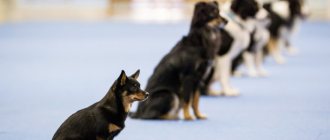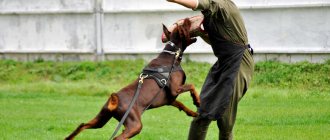How to start teaching a team correctly?
Initial training should be done in private, where there will be no distractions. The “Come to me” command must be learned during a walk or specifically during the training process. First you need to shout the dog’s name, and then “come to me.” It turns out “Labrik, come to me!” To attract the dog's attention more, you can clap or whistle.
If the dog does not react, you can run away from him. Most likely he will want to play catch-up, and you will get the desired result. When attention is attracted and the pet happily runs after you, it is important to repeat “come to me, dear (or nickname), come to me” a couple of times. The most important thing is that your voice sounds good-natured and joyful. You can also say the phrase “good (nickname).” And so it turns out “Come to me Labrik, come to me”, “okay Labrik”, “okay my boy”. Words of approval will greatly benefit you, once again strengthening your relationship.
When the dog has already run up to you, be sure to give a treat, pet it and repeat the words of the command. Over time, you won’t need to give your name; the dog will simply recognize your voice and intonation and immediately carry out the command. It is especially important to remember that after the dog has approached you, you should not immediately put a leash on it. Even if this is the end of the walk. When she comes over, play with her for a few more minutes, but don't let her go too far from you.
When you put on the leash, also run for a few minutes and encourage each other. Otherwise, if the dog understands that “Come to me” means immediately on a leash and go home, then later it will not want to come. Another important point is that when the command is executed flawlessly, sometimes give a treat. Approaching the owner should always bring joy. Strengthen your relationship and it will bring you mutual pleasure.
How to train a dog
Next, let's look at the specifics of how to teach a dog the “Come to me” command. Let's talk about the initial and final options, which involve performing an action without providing a reward.
Rules for following a command with treats
An animal, like a person, will perform certain actions only if it receives some kind of reward, so we will teach the animal a command with the help of various treats.
Let's start with the fact that before starting training you need to purchase a long leash and a snatch chain (a collar made from a chain).
Read the rules for choosing a collar.
Once you have acquired everything you need, you can begin training. You need to go out with your dog to a deserted place. An open field, forest or park is suitable.
In this case, the following condition must be met: there should be no anything in the open space that can distract the dog (cats, other dogs, people, vehicles, etc.).
If this condition is not met, then you will spend much more time, since the animal will be interested in contact with the above objects or animals rather than following your command.
After you have taken your pet for a walk, you should give him time to run around, throw out his energy, so that it will be easier to deal with the dog. It is important to understand that until the animal has played enough, it will not concentrate its attention on you and your voice, so strictly follow the instructions.
When the animal gets tired, move back to the maximum length of the leash, then call the pet by name. The dog should pay attention to you. If this does not happen, lightly tug the leash.
After the dog has paid attention to you, you need to clearly say the phrase “Come to me.” The phrase must remain unchanged for the dog to remember it.
Many dogs immediately understand what you want from them, after which they come to you, but if the pet does not react in any way, then you need to call it with a gesture (a hand gesture when we want to give the animal some food).
If after this the dog does not react, then you should pull the leash so that the dog comes over. It is important to understand that the jerk should not injure the dog, otherwise all training will come to naught.
After the pet has come close to you, you should pet it, thank it and give it something tasty. After rewarding, you should let the dog go for a walk.
Such simple manipulations develop in the animal the correct reaction to spoken words. The animal will associate the phrase “Come to me” with affection and tasty food, so it will not resist.
Important! You cannot punish a dog for not following a command, otherwise an appropriate association will be developed.
Training without treats
If you are familiar with dog competitions, then you know that rewarding the animal for each command is inconvenient and very slow (the entire process of executing a series of commands will slow down).
Also, you may not always have any goodies with you, which is why the animal may think that you are being unfair to it.
To avoid problems with a trained animal, we will figure out how to teach a dog to the “Come to me” command without rewards.
Many novice trainers have problems when the pet refuses a treat or food is not a stimulus for performing exercises. In this case, you need to find another weakness of the dog. This could be a favorite toy, an ordinary small ball, or some kind of stick.
Dog breeds that are difficult to train include the Irish Setter, Saluki, Chow Chow, Sealyham Terrier, Central Asian Shepherd Alabai, and Basset Hound.
It is very easy to attract a dog, as he is interested in what is unfamiliar to him, so you can improvise with different objects.
If the dog is not interested in treats or any objects, including toys, you should teach it to follow a command, relying solely on the leash. To get your dog to come when you say a command, you need to say “Come to me” loudly once, and then pull the leash.
After the dog has approached, you should pet it and release it. You should repeat the action until, after the first repetition of the command, the pet begins to approach you.
Important! No animal will learn a command in one training session, so be patient and persistent within reasonable limits.
General principles of training
Dogs are trained in two different ways. According to the first, they must learn to obey as service dogs do, in accordance with accepted norms and training techniques (OCT). In the second case, it is enough to teach the dog basic skills that can be used daily.
The dog must know that after pronouncing the order “Come to me”, it approaches the person. For this:
- She is released on a long leash 1-2 meters away from her.
- They voice the command and pull them towards them.
- The approaching dog is stroked on the head and treated with goodies.
If something doesn’t work out for the dog the first time, you shouldn’t scold him or, even worse, beat him. When following a command, your pet should have only pleasant associations at any stage.
Important ! The approaching dog should not just stand next to the owner, but sit down.
The “Sit” command is taught even earlier. A service dog, trained according to certain standards, approaches a person, walks around him on the right side, goes behind him and sits on his left. Only after this is she worthy of a reward in the form of a treat.
A dog that responds to a command immediately after it is spoken is considered to be well tamed. She should not linger on the way or look around.
Choosing a place to train your dog
How to teach your dog the “sit” command at home
To begin with, small dogs can be trained at home, the main condition is that the dog and the owner are completely alone in the apartment (nothing should distract the dog from studying). Large dogs are taken outside, away from people and other animals. To do this, they go into the forest or go to sports fields early in the morning or at the height of the working day.
The dog should be comfortable, but not familiar. After 1-2 weeks of training, the location is changed. The dog must understand that he will have to follow commands in different situations and in any environment.
Command "Sit"
Executing a command according to the standard
On the command “Come to me!” the dog must approach the owner and, going around him on the right side and behind, sit at his left leg. Therefore, the basic skill is acquired according to the scheme described above. But when the animal approaches, they make it clear that you need to go around to the right and behind, and only then sit at the owner’s left leg. To do this, guide the animal, attracting its attention with a treat held in the right hand. The dog will follow the hand, behind the back the treat is transferred to the left hand and they continue to guide the dog, and when it is at the left leg, they command “Sit!” For correct actions, the animal is given a treat and verbal praise. As the results improve, they reduce the frequency of rewards and practice the exercise, indicating actions with gestures (walking around, sitting), and not with their voice.
Ways to teach your dog the command “come to me in any situation”
The most important thing to understand is that you are not the only one with this problem. There is no need to panic or get angry at the dog. It’s just that training needs to be given more time and attention than it seemed at first glance. And under no circumstances hit the dog! This will make her angry, and she will either be afraid to approach you, or it will cause her aggression with harmful consequences. The animal's approach to you should be associated exclusively with positive emotions.
With kindness and love you will bond your pet to you much stronger than with anger and threats. The following tricks can be used:
- Very long leash.
- While walking, let go of the leash and give your dog freedom.
- After a few minutes, call her over.
If the dog does not listen to you, lightly tug on the leash and draw her attention to you. Repeat the command “Come to me” and entice the animal with a treat. After completing the command, be sure to praise and pet your pet, and also treat it with a treat.
Approval and stroking. It is very important to praise the dog for following a command, to let it know that you value and trust it. Affectionate words should be pronounced with soft intonation, repeating the nickname several times. Stroking should be fun, you can lightly pat him between the ears, pat him on the rump. Gently!
Delicacy
You need to take a treat with you to each training session. This can be dry food if the dog does not eat it regularly; pieces of sausage or hard cheese (depending on your pet’s preference). It can be absolutely anything, the main thing is that it is easy to get out of the bag and it is small and in pieces. In this case, size matters. After all, if you cut it into large pieces, the animal will quickly get full and lose interest in training. It is also important that the dog is not full.
After breakfast it takes several hours to pass. Then the animal will be more willing to obey commands. Treats can be alternated with praise, but the interval between praise and execution of the command should be no more than 3 seconds. Otherwise, the dog will not understand why he is being praised and given food.
Toy
When a dog is on a walk, he is often already in a good mood. And a toy or some kind of stick can cheer her up even more. When the dog runs a few meters away from you, you call it loudly but cheerfully and beckon it with a toy. By doing this, you let the animal know that a fun game is about to begin.
When the dog's interest is focused on you, voice the command “Come to me” several times while showing the toy. Play with the animal for a while and make it laugh. By doing this, you will only strengthen your connection with him and endear him to you in the best possible way.
Methods
How to train a puppy
The main thing is to establish a boundary between the game and the execution of the command; the game can be an encouragement.
My dog is very interested in the world around him: nature, people, animals. Therefore, when studying outside, I tried to choose a quiet place, but even there he managed to be distracted by everything around him.
For this reason, I began to pronounce the command only at the moment when he was already running towards me. When he runs up, I’ll pet him and give him a treat. Then I wait to play or enjoy nature.
If I saw that he was looking in my direction, I would say the command again. Doesn’t react - I easily pull the leash in my direction, at first this caused misunderstanding, but then he came up and again received approval and affection.
After two days, I began to move a greater distance and pronounced the command along with the nickname “Achi, come to me!” simultaneously tapping his knees.
A couple of days later she called without a nickname. The algorithm was this: practicing the skill 3-4 times, then playing and resting. After 5-10 minutes, work again.
She trained on a leash, gradually increasing the distance, and eventually removed it completely. We worked out 2 times a day during a walk in the morning and in the evening on an empty stomach, so it was more convenient, and 2 times at home to consolidate.
How to train an adult dog
Only a professional can train an adult dog from scratch. If a dog is not trained in basic commands, it is impossible to control it.
If you decide to train an adult dog on your own, you will need much more patience than with a puppy.
The principle is the same, the basis should be a positive association, without using punishment. If the negative reflex is already firmly established, use another expression when training, for example, “Toe!”
If you have basic skills, you can complicate their implementation, for example, using OKD (comes up and sits near your left leg).
You can also complicate the implementation with a set of exercises. After the dog has approached, say “Sit!” and only then hand over the treat.
Home training for puppies
Not knowing how to teach a puppy the commands “Come” and “Fu,” they begin by determining their age. Young dogs become receptive to training from 2-3 months.
If the dog is playful and does not want to stay in place for a long time, then two people should take care of it - the owner and a stranger. If this is not possible, the owner will have to establish boundaries between play and commands - the work that the puppy must do.
Important! You can train only those puppies who already know their name - when it is pronounced, they express joy, whine, and wag the tip of their tail.
They move away from them at some distance and do not allow them to get closer, moving even further after attempting to do so. As soon as the puppy freezes in bewilderment, they begin to pat themselves on the knees, attracting attention, and pronounce the desired command. The dog that runs up is rewarded.
During a walk, you can make 3-4 attempts, but so as not to overtire the animal.
Whistle training
Adult dogs (1 year or more) are often trained to respond to a whistle by:
- The animal is taken to a place far from people.
- Let off the leash.
- They wait for the dog to start frolicking and running.
- They move some distance away from him.
- They blow the whistle hard.
- If the pet does not react, the action is repeated more than once.
As soon as the dog turns towards the sound and begins to look towards the owner, they whistle again, after which they pronounce the command and wave a piece of treat.
You will have to repeat the process from the whistle to the execution of the command repeatedly. It all depends on the character of the pet and the breed. Shepherd dogs remember orders almost the first time, but other dogs, including outbred dogs, have difficulty following them.
Important! It is impossible to completely refuse rewards; a dog that is confident in receiving a treat will stop trusting a person if he deceives her several times in a row.
Paired learning
The easiest way to teach a dog to carry out basic orders is to act in tandem with someone:
- The owner remains in place with a treat clutched in his hand.
- The second person moves 1-1.5 meters away from him, holding the pet on a leash.
- The command “Come to me” is pronounced.
- The dog is released from the leash and slightly pushed towards the owner.
There is no need to shout the same thing over and over again. To get the dog to come over, they say an order and show him a treat. It is better if the food smells good and is familiar to the pet. The first 10-12 times you will have to act this way. As soon as the dog understands what they want from him, they begin to hide the treat in his hand or give it every other time.
At what age to start
Dog handlers do not recommend delaying it, but starting training at 2-3 months. This is the optimal age, because the earlier you start, the easier it will be to master.
You should not do this earlier, since the dog has not yet been socialized and is not accustomed to the street. Moreover, it is necessary to go through the stages preceding training: accustoming to a nickname, a toilet, a place, a walk.
You shouldn’t overload your puppy with everything at once, but gradually move from mastering one command to another.
Features of training with an adult dog and a puppy
There are no dogs that cannot be trained. However, as an animal ages, it becomes more difficult to train. After two years, a pet develops habits and character traits that are extremely difficult to change.
Features of training with an adult dog and a puppy:
- the optimal start of training with a small pet is 1.5 months;
- from the first months of the puppy’s life, clearly define the circle of owners;
- give the baby maximum love, care, affection;
- the first training sessions are games during which the puppy learns the basics and basic commands;
- raising an adult animal will require more patience, effort and time;
- you cannot be overzealous and forget about praise;
- It is not recommended to combine two types of reward; it is better to choose one thing - a treat or proper praise;
- After class, be sure to play and have fun with your pet.
It is necessary to train an adult animal or puppy with the premise that you will have to teach them to unquestioningly carry out at least basic commands. This will require daily training. The main thing to remember is that the animal initially knows how to lie, sit, and give a paw. During training, interaction with each other occurs, which requires dedication on both sides.
Actions that are prohibited to do
- You cannot repeat the same command several times. After voicing a command, the dog must immediately carry it out, unquestioningly. If you shout “Come to me” several times, she will do it the fifth time. It is necessary to achieve the execution of the command by cunning, tricks, and treats. And when the dog approaches you, you need to stroke it and repeat “Come to me, my boy (girl)” several times. In this way, the dog will develop an understanding of what exactly it is being praised for.
- Do not call the dog if you feel that he will not come. In order for your dog to unquestioningly approach you in a stressful situation, you need to work on its behavior as a whole and develop your authority. After all, a dog is a pack animal and a leader is very important to it. If she sees you as a leader, then training will become less problematic. All commands must be practiced calmly and their execution brought to automaticity. Then an unforeseen situation for the dog will not be a reason for the owner’s disobedience.
- It is forbidden to punish a dog while it has already approached. Even if not the first time. Having punished her once for disobedience, and if she also hit her, she may lose trust in you forever and then no amount of training will save you. You cannot punish, even if you have already done something wrong. It’s better to monitor the moment of harm and immediately scold it. But when he comes to confess, be sure to praise him.
Breed characteristics of training
A pet's ability to raise and learn is influenced by its breed and breeding goals. Centuries ago, people began to breed new varieties - to protect the territory, help in hunting, and herd livestock. This was reflected in their character traits and habits, which were passed on to modern animals. It is known that herding breeds are more prone to training.
Breed learning characteristics take into account various factors in a complex (mental abilities, attitude towards people, speed of memorization, character traits).
Top ten breeds:
- Border Collie;
- poodle;
- German Shepherd;
- Golden retriever;
- Doberman;
- Sheltie (Shetland Sheepdog);
- Labrador Retriever;
- papillon;
- Rottweiler;
- Aussie (Australian Shepherd).
After these tens, the level of learning gradually decreases. The rating ends with the breed – Afghan Hound. However, this does not mean that animals are stupid. The Afghan Hound is an ancient breed, the representatives of which have independence at the genetic level, which interferes with training.
FAQ
What to do if the dog doesn’t listen and runs away?
It's the owner's behavior. Study all possible errors and the reason will be found. Analyze your behavior, how consistent and persistent your actions are. Also, you should not expect the final result on the first day.
Why did the dog stop responding to the command “Come to me!”
There may be several reasons, but they all also depend on the behavior of the owner.
- Mood . If, after a hard day at work, in an irritated state, you go for a walk without the mood and lash out at your pet. Relax and go for a walk with renewed vigor.
- Long breaks in classes . If today you conducted a training session, and the next one a few days later, there will be no result, the dog simply will not take you seriously or the importance of following the command. So plan your schedule in advance.
- Walking too fast . The pet will not have time to relieve itself, enjoy the world around it and follow your instructions in 10 minutes. Keep in mind that the walk takes on average half an hour.
- You catch up yourself . You are the leader and you make the rules. If you want to leave, but the dog does not listen, start moving away in the opposite direction, saying your pet’s name.
- Cruel treatment . Severity does not equal cruelty. The pet is worried and nervous if the owner is cold and rude, and will constantly expect punishment from you and be afraid.
If you see that mastering a skill is hopelessly lost, start acting from the very beginning, using another word, for example, “Here!”
Team "Come to me"
I want to say right away that I will not describe severe and advanced cases. We will talk about puppies and young dogs when this problem is just beginning to arise.
You are all familiar with the picture - in the evening, an angry and angry owner (work is not always fun) tries to catch and drive his boyfriend into the entrance, and in an excessive manner.
cheerful, pet. The owner has already tried all the tricks, and each time he has to be more and more inventive. The poor guy (the dog) sits at home all day, he is bored, but, unfortunately, the owner does not understand this.
The main problem that arises when walking a dog is completely ignoring the command “Come to me!” You scream, repeat it dozens of times, but your dog goes about his business and doesn’t even listen. Annoying? Then let's get out of this situation, and as soon as possible.
Everyone wants to have an obedient dog that doesn’t pull on the leash and comes on command, but it takes a lot of work. Working does not mean mocking the dog, but, above all, thinking. Think about how the command should be executed? What should your dog do when you say the command and gesture? Think it through in detail, down to the smallest detail. And not “as it should” or “as it is written in books,” but in a way that is convenient for you personally. It is most important!
What should a pet do on the command “Come to me!”? How should he approach you? There is no law or strict limitation here, it is your dog and you make the rules here (provided you are not training your dog for certain types of competition). The main thing is that every command must have a beginning, continuation and end . That is, what many people forget: the dog must be released from command! If it’s convenient for you to have your dog sit next to you when approaching you, for God’s sake. If you want her to sit in front of you, no question, you are the owner. But she must sit down, record her approach, and not just run past. For what? So that you can hold her in case of danger, to cross the road, so that you can take her on a leash.
Under no circumstances should you punish a dog for slow execution of the command “Come to me!” or unwanted behavior (barked at someone), if she did approach the owner. Also, the punishment is too late and will not bring results other than negative ones. It must be remembered that the dog should be punished for the behavior that it exhibits at the time of punishment (in this case, for failure to comply with the command “Come to me!”). If the owner scolds the dog for approaching him too slowly, this will lead to the fact that in the future the dog will approach the owner even more slowly or not at all.
After the dog approaches the owner, do not immediately fasten the leash, even if it is time to go home. The dog will develop a negative reflex: when it approaches its owner, there is no freedom to be seen. First you need to praise the dog, pet it, and give it a treat for obedience. Give any command, for example, “Sit,” without forgetting to praise, and only then fasten the leash after a short pause. However, in this case, the dog must once again be praised, stroked and rewarded with a treat for “cooperation”.
Don't create problems for yourself. By allowing your dog to ignore the “Come to me!” command once, you yourself provoke and encourage him to further disobedience. If you know you are going for a short walk, do not let your pet off the leash. Walk along a route familiar to your dog.
If the dog does come, do not punish it.
So, how does a dog learn the command “Come to me!” "?
First of all, I recommend keeping a diary/diary where you, throughout the entire training course, will enter data on changes (both in classes and in raising the dog).
Ask yourself: Do you want to exercise with your dog today? Are you in the mood? If not, don't. The dog senses that you don’t want to work, that there is no confidence in your voice, but only irritation, and will not listen to you. There will be no sense in studying. Training a dog is easy and simple only at the moment when there is courage and enthusiasm inside, when there is a desire to achieve results and there is strength for this. Your dog should do everything with pleasure and interest.
First, conduct classes in an environment with minimal stimuli. Cars, people, strange dogs - nothing should distract your pet's attention. When calling a dog in an apartment, say its name and the command “Come to me!” with moving back and, after completing it, reward it with a treat (these can be small pieces of cheese, sausage or raisins. One thing is important - this should not be the animal’s everyday food, but a treat. So don’t take it with dry food, the dog is already receives it several times a day. The treat should be the size of a pea - we do not feed the dog, but reward it by using it during exercise. The dog does not receive a treat at any other time), exclamation “good” and stroking (no matter what consistency, but be sure to use all three types of reinforcement!). At the first stages of the training process, when calling the dog to him, the owner should extend his hand, showing the dog a treat. From a great distance, the dog will not see the treat itself, but it will quickly learn to recognize such a gesture and such hand movements, and understand their meaning. The dog should be called only if the owner is sure that it will stop what it is doing and come to him. The dog owner should show joy and generously reward his dog with praise, petting and treats, even if he is slow in following the command and if the owner himself is very angry due to excessive slowness.
Gradually, as you learn, stand up to your full height when the dog runs towards you. Also, praise her the moment she walks towards you . Encourage her, tell her that she is doing everything right.
You need to achieve endurance after executing the command “Come to me!” This needs to be done gradually. Do not let go of your pet right away, hold him by the collar, give him another piece of treat, pet him, try to sit him next to him. This may be useful in the future, because... Young dogs sometimes acquire the bad habit of running up on command and running away before the owner reaches out to the collar. If your pet ignores the command, immediately call him again and start moving in the opposite direction.
Keep two laws in mind:
1. Every time the command “Come to me!” is canceled by the command “Walk! ".
2. Do not let your dog get up until you release him with the command “Walk!” ".
If she jumps up when you praise her, stop praising and put the dog in the same place. You must feel and find the action that disrupts the dog from the command: stroking or overly emotional praise. And try not to make this mistake next time. All dogs are different, for some it’s enough to say “Okay, well done,” but for others you need to turn yourself inside out so that the dog understands that the owner is happy with him. Feel the dog!
Achieve, plant, praise, and then let him go for a walk.
First, hold your pet for 3-5 seconds. At this time you can pet him and talk to him. With each subsequent command, increase the time spent next to you by 5-7 seconds. Gradually increase this time to 30-40 seconds. If, nevertheless, he does not obey, hold him back with your hand.
If the dog does not come to the owner immediately after he called it, you need to turn in the other direction and walk forward until the dog notices this and follows him. As soon as the dog begins to move towards the owner, you need to praise the pet, and then reward the pet for the approach, no matter how long it took.
Don't demand perfect obedience from your dog the first time.
When you see that your pet has begun to follow the command reflexively, gradually remove the treat, leaving only vocal encouragement and stroking. To do this, when the dog executes the command “Come to me!”, remove the treat after one, two, three times. Constantly change the sequence (every two, one, three times) so that your pet does not develop a habit. The dog should not guess when you give the treat. She will try to fulfill the command even better, come to you even faster, she will learn perseverance and discipline, endurance.
But in any case, you need to encourage him with a “good” voice, smiling, and petting him. This is so that she knows that she was told “good” for following the command “Come to me!” And start all over again.
Did it work out at home? Now go outside with your dog. Take a motivation treat with you. The only thing you need to know is to conduct the lesson in a fenced area.
Look around: you should be alone - the strange dogs are gone, there are no people nearby. Let's start working. For a while, forget about the “Come to me” command. The mistake of many owners is that they shout it whenever they hit it, without caring at all about its implementation. Well, a dog ran past and glanced in their direction - and that was good. Not good! Forget this command! Don't shout at her, you won't teach the dog anything good.
Carefully watch and observe the dog: how it behaves, what it does, how it communicates with other animals. Don't forget that she is a living being, and she has her own desires, interests and concerns. Call her over, notice when she comes and when she doesn’t. Very quickly you will notice that situations in which the dog is not suitable are repeated. It depends on the type of irritants and their strength - foreign odors, people and animals (to which the dog is not yet sufficiently accustomed). If the “Come to me” command has not yet been learned, calling it at such moments is not only useless, but also should not be done. The command loses strength and, as a result, the command is not followed. There is no need to shout to the whole neighborhood if the dog is not paying attention to you. It makes no sense.
Call the dog. Remember: a nickname is not a command, it’s just a button that turns on the dog’s attention. The dog raised its head and looked in your direction. Wonderful! Now is a good time to call her. Squat down, extend your arms towards the dog and gently say “Come to me!” » In most cases, the dog will happily run to you. When she comes over, try to sit her down. First, pressing on the back of the body, then simply with the command “sit.” As soon as she sits down, give her a piece and praise her very kindly, tell her how wonderful and good she is.
If the dog does not respond to you, wait a minute and repeat the name and command. If the dog raised its head and looked at you, repeat the command again. The likelihood that she will come up at this moment is very high.
A small example: you could quite often see how dogs, when meeting, freeze for a few seconds a couple of meters from each other, as if thinking about something, and then approach. It is at this moment of “thinking” that dogs readily approach. Seize this moment. This help will help avoid not only a conflict situation, but also a fight.
If it doesn't work the first time, it's okay, try again. Don't lose confidence in your abilities! And don't show your dog that you are giving up.
Under no circumstances repeat the command more than two or three times. The dog hears you perfectly well, but there are irritants that are even stronger. An often repeated command loses its meaning for the dog, and it stops responding to it.
I will not believe the person who says that his dog ALWAYS follows ALL commands. Surely there are times when she does not obey, and the command has to be repeated - this is normal .
As you continue to exercise outdoors with more stimuli, gradually reduce the frequency of using treats. Give your dog treats only occasionally, but so that the dog does not know when he will receive a reward for a job well done. However, don't give up the treat completely and continue to praise and pet your dog for his obedience.
Instead of a treat, you can use a ball, a cigarette (grip) or some other object as a reward if the dog likes to play with it. You must always have the ball with you during walks and throw it to the dog only as a reward for following commands, as well as additional reward for bringing the fetch item.
Remember that you need to give the treat immediately after the dog sits down, but not before. After a while, she will sit down on her own, coming up to you. And at this moment the praise should be very sincere, because she did everything correctly and thought of it herself.
Watch your dog carefully when you give him a piece. Many people tend to give it when the dog rises to reach the treat. Make no mistake! In this case, you will reinforce her getting up!
There is no single approach, you need to try, look for ways, experiment, because dogs, just like people, are different.
If you can’t use a harsh voice, sit down and call gently. Your target is a dog, not far from you. If you manage to call the dog after repeated attempts, be sure to praise it and give it a piece of treat. Why? Because you took her away from stronger stimuli and she came over. This way the dog will quickly learn that approaching the owner is always more pleasant than anything else.
If you can’t call someone kindly, raise your voice, assert your tone, become persistent, get angry. When working with a dog, you need sincere emotions. The dog will work well only when there is confidence in your voice.
Another situation: there is no one around, but the dog approaches the second time. Don't praise, just say "Okay" and let go. And after a few seconds, give the command again, but with a treat ready. The dog just left you, but it will return, and here, sincerely rejoice and give a treat. The dog will understand how and when to approach.
Be persistent and stubborn. Achieve correct execution, and not “just to fit”. Dogs love to show their character and move towards their owner slowly. Don't let them throw you off balance and scream or spit at the command. This is exactly what they are trying to achieve! It will be your loss and their victory!
Learning proceeds gradually, in spurts—sometimes better, sometimes worse, but always leading to a return to disobedience. And that's okay. Are you always in the mood to work? It's the same with dogs. Remember, only perseverance can achieve results. Don't be afraid to correct your dog. The more clearly you imagine the ideal command, the more consistent you are in your desire to achieve it, the better your dog will obey.
You have taken the first steps towards properly training your dog - you have begun to explain to it that there is nothing better in the world than the “Come to me” command.
Rejoice at successes, both big and small, show your joy to your dog. But don't force things.
Problems that may arise. And their correction.
If you taught your puppy to take care of himself from a very early age, you encouraged him to approach after the command “Come to me!” “If you didn’t put him on a leash right away, as a rule, no problem arises.
There is no need to be scared when an older dog begins to lose control. This could happen for several reasons:
1. Transitional age (the dog may begin to assert itself). There is a possibility of dominance in the relationship between owner and dog. Most dogs that ignore their owners' commands also exhibit other forms of behavior that show disrespect for humans. That is, in other words, the hierarchy in the family has not been resolved.
In this case, I recommend contacting (before it’s too late) a trainer who will help you correct your pet’s dominant behavior. It is possible that he will find more than one type of dominance. If such problems are discovered (and this happens often), I recommend obedience training to the dog owner.
2. The dog is not trained to obey and, on top of this, is unintentionally trained not to obey the command “Come to me!” “ I’ll explain: dog owners who are faced with problematic behavior in their pets begin to change the dog’s behavior, but not consistently, but: “I want it that way.” Although they resort to methods that are used by lovers of trained dogs, from the first days of a puppy’s life. The peculiarity of these methods is to reward the dog for following the command “Come to me!”: with praise, affection, kind words, stroking. The biggest mistake (which is developed to the point of automatism) is to scold the dog for late execution of a command after it has finally approached the owner. This only makes the problem worse. Dog owners, oddly enough, realize their mistake, but experience strong rage, irritation and, as a result, cannot behave differently. In addition, when the dog finally approaches the owner, he concludes that this method brings results, because the dog walks, albeit hesitantly, with his head and tail lowered, without looking the person in the eyes, “as if he knows for sure that he did something wrong.” Therefore, the owner believes that punishment increases feelings of guilt, and this, in turn, reduces the occurrence of unwanted behavior. But the dog shows signs of fear because it is being punished even though it did approach its owner. That is why the approach is delayed.
Don't think like a person. Think like a dog!
3) Increased sexual instinct. In such cases, I recommend using a long leash. He usually brings the dog to his senses. After the command “Come to me!” and the dog’s obvious reluctance to carry out the command, it is necessary to make a sharp jerk with the leash. After the approach - praise, a treat. Then be sure to let the dog go for a walk .
4. The dog may have a strong motivation for other, stronger stimuli. For example: playing with relatives, chasing a smell, chasing prey - pigeons, cats, a ball). The speed of the dog’s reaction to the “come to me” command will depend on what it is doing at the moment. If she has lost interest in what she was doing before, and if there are no stronger stimuli nearby, then it is likely that she will immediately follow the command. But if there are relatives nearby with whom the dog has already started greeting, playing, etc., it may not “hear” the command of its owner. Many dog breeders complain that their pets follow the command “only if it suits them.” That's right, because there is a stronger stimulus.
A few more recommendations for correcting behavior:
When buying a puppy (especially a working or sporting breed), you must be sure that you will be able to devote a lot of time to walking and training. Otherwise, unrealized energy will not come out in a good way - a trashed apartment, torn sofas, pillows, restaurant suits and clothes.
Train your dog from puppyhood. And after completing the training course, work with the older dog several commands a day, ensure that they are carried out correctly. Don't give up.
If the dog runs up after commands and jumps away, punish it - a sharp jerk with the leash. And then a strict command - “Come to me!” Encourage the dog’s movement towards you with gentle words, give the offending pet the opportunity to correct itself.
I recommend using an electric collar only in a fenced area, and only under the guidance of an instructor. An unexpected electric shock can lead to the opposite effect - the dog will run away wherever its eyes are looking.
Material taken from: dressirovka.co.il
Tweet











